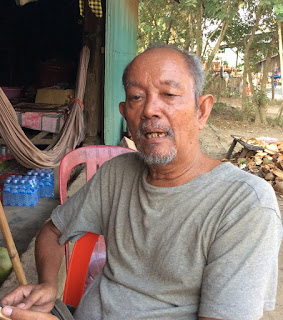I had never been to South-East Asia at all before coming here. Er, it's hot. Cambodia is tropical. Half the year in an oven and half in a sauna, they say. This is the oven half. I chose this time of the year to travel here because (1) the Alsace winter is no fun; it's more the dark than the cold that's hard to bear (2) in January and February there's nothing much to do on the allotment. Our place is sold - the keys were handed over 48 hours before I left, and the last three days in Strasbourg spent in a hotel - so with no housing or utility costs for the next few weeks, and significant other with his own flat, it was feasible for me to travel and stay there for a while. So, hey, a big change.
We know the history of Cambodia, or we think we do. The Killing Fields, the Khmer Rouge. It was 40 years ago, thus in living memory. In Phnom Penh, and elsewhere, you quite often see people with no foot, no leg, or no arm. They are all, pretty much, or appear to be, fifty-something. You don't see many others that age at all. About a quarter of the population was lost to starvation, murder and death by forced labour. Genocide, let's not mince our words. The effects are still felt now, as the intellectuals were killed first and the universities closed, meaning that when it all reopened there was no one much left to do the teaching. If you were alive and could read and write after that you could teach, so quality education is only starting to be available now.
Anyway, enough of the history. Others have written it better than I could. I'm currently reading Ben Kiernan's 'How Pol Pot Came To Power' (pub. 1985, updated 2004 - an academic history which is readable and a good source book) and in the first few days I was here I re-read Margaret Drabble's 'The Gates of Ivory' (pub. 1991 - the Kiernan is in the bibliography: a novel which is full of great stuff and picks up most of the characters from the earlier two in her trilogy 'The Radiant Way'). Recommended. The late Doris Lessing wrote somewhere that her generation (born in the 1920s and 30s, the one before the boomers, with the war babies' mini-generation slotted in between, what has been called the Greatest Generation, though not by me) was the first to go primarily to works of fiction for information about the world. And so it is and has continued.
The Khmer Rouge wore uniforms like these. They wanted the purest communist land, starting at Year Zero. They left behind - well, not much really. And the Khmers picked themselves up and started rebuilding their country. What was left of it.
 |
photo taken by me at Tuol Sleng Museum of Genocide, Phnom Penh
|
And here is a survivor. I met him today near Battambang, Cambodia's second city. He speaks OK English and better French. His name is Suon Som and I was pleased to hear some things about his life. He says he is 74 years old. He says he was a general in the army - careful not to say which army or exactly when; the framed picture of him in uniform he showed me is very hard to date, and you can't see the uniform properly. He also showed me a certificate authorising him to be an election observer in the Cambodian National Assembly election of 2003, an observation mission partly funded by DFID. He also says that Johnny Hallyday came to see him in Cambodia. Well, maybe he did. Though so far I can't verify that Johnny ever went to Cambodia, but why would he not, he has many fans there, or had. I'd love to go back and talk with Suon Som again.
 |
| Suon Som.photo taken by me 22nd January 2016 |
1 comment:
Wow. Sounds very good. Hate those uniforms and love The Radiant Way.
Post a Comment